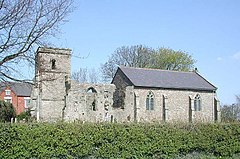|
Elmesthorpe
Elmesthorpe (sometimes spelt Elmersthorpe, Elmsthorpe[1] or Aylmersthorpe[2]) is a village and civil parish in the Blaby district of Leicestershire, England. It is situated to the south-east of Earl Shilton, near to Hinckley on the A47 road. In 2004, the parish had an estimated population of 520,[3] reducing to 509 at the 2011 census.[4] History The village's name means 'outlying farm/settlement of Æthelmaer or Ailmer'.[5] The village has been inhabited from at least Roman times as there is evidence of Roman occupation within the parish.[6] In 1297, Elmesthorpe was home to numerous farms and 40-50 families. The Black Death and a failing economy caused the village to depopulate and for a time disappear.[2] In 1485, it is thought King Richard III and his troops stayed in the partially ruined church for shelter on their march from Leicester to the Battle of Bosworth; with the king and his officers sheltering within the church, and the soldiers camping outside.[2][7]  The parish church is dedicated to Saint Mary and was built in the 13th century.[1] It had "long been in ruins" by the mid 19th century, but the tower was still standing.[1] In 1869 the church was partially rebuilt, in a smaller scale, within the ruins of the church.[1] This, the present church, occupies the east-end of the church and is accessed through the Tower and west end of the church, which have been left as ruins. The village's population had begun a slow recovery by 1710, at which point 40 people were recorded as living in the village.[2]
In 1871, The Imperial Gazetteer of England and Wales described Elmsthorpe as:
In the 1920s a boot and shoe manufacturers opened in the village, called "Harvey, Harvey & Company".[2] In the 1930s, the government started to address the population of Elmesthorpe, which had not recovered from its collapse in the 13th century. The government initiated a scheme which brought families from depressed areas to make a living from the land. In 1935 Church Farm was purchased by the Land Settlement Association, who built 43 smallholdings in the village.[2] This continued to the 1960s, when the scheme ended. Many of the smallholdings were then purchased by their tenants.[2] The 1960s saw both the railway station and the shoe factory close.[2] References
External links
|
||||||||||||||||||||||||||||||||||||


